Analyzing Hospitalization Processes Under the Affordable Care Act
VerifiedAdded on 2023/01/18
|9
|2317
|98
Essay
AI Summary
This essay provides an in-depth analysis of the procedures involved in a typical hospitalization or emergency department visit under the Affordable Care Act (ACA). It details the processes from admission to discharge, encompassing inpatient care, outpatient care, observation status, and rehabilitation services. The essay highlights the financial aspects, including insurance coverage and billing practices, and compares these procedures with the healthcare landscape before the ACA's enactment. It explains how the ACA aimed to minimize uncompensated care by mandating health insurance, influencing the roles of healthcare facilities and professionals. The essay also touches upon the differences in access to care, particularly for low-income patients, and the impact of the ACA on managing costs and ensuring appropriate care settings. The conclusion reinforces the ACA's impact on healthcare access and affordability, emphasizing its role in safeguarding patients from overcharging and establishing guidelines for financial assistance.
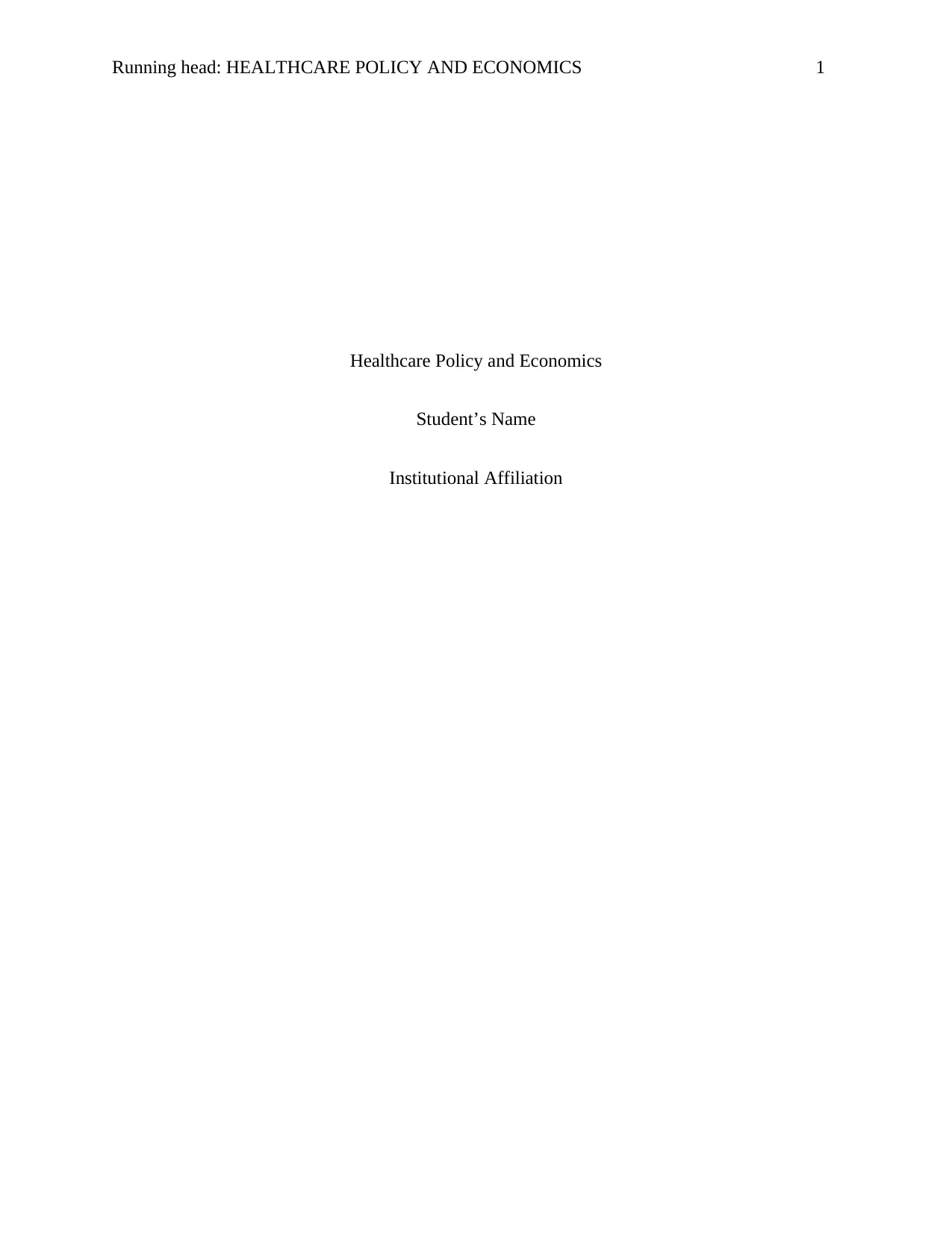
Running head: HEALTHCARE POLICY AND ECONOMICS 1
Healthcare Policy and Economics
Student’s Name
Institutional Affiliation
Healthcare Policy and Economics
Student’s Name
Institutional Affiliation
Paraphrase This Document
Need a fresh take? Get an instant paraphrase of this document with our AI Paraphraser
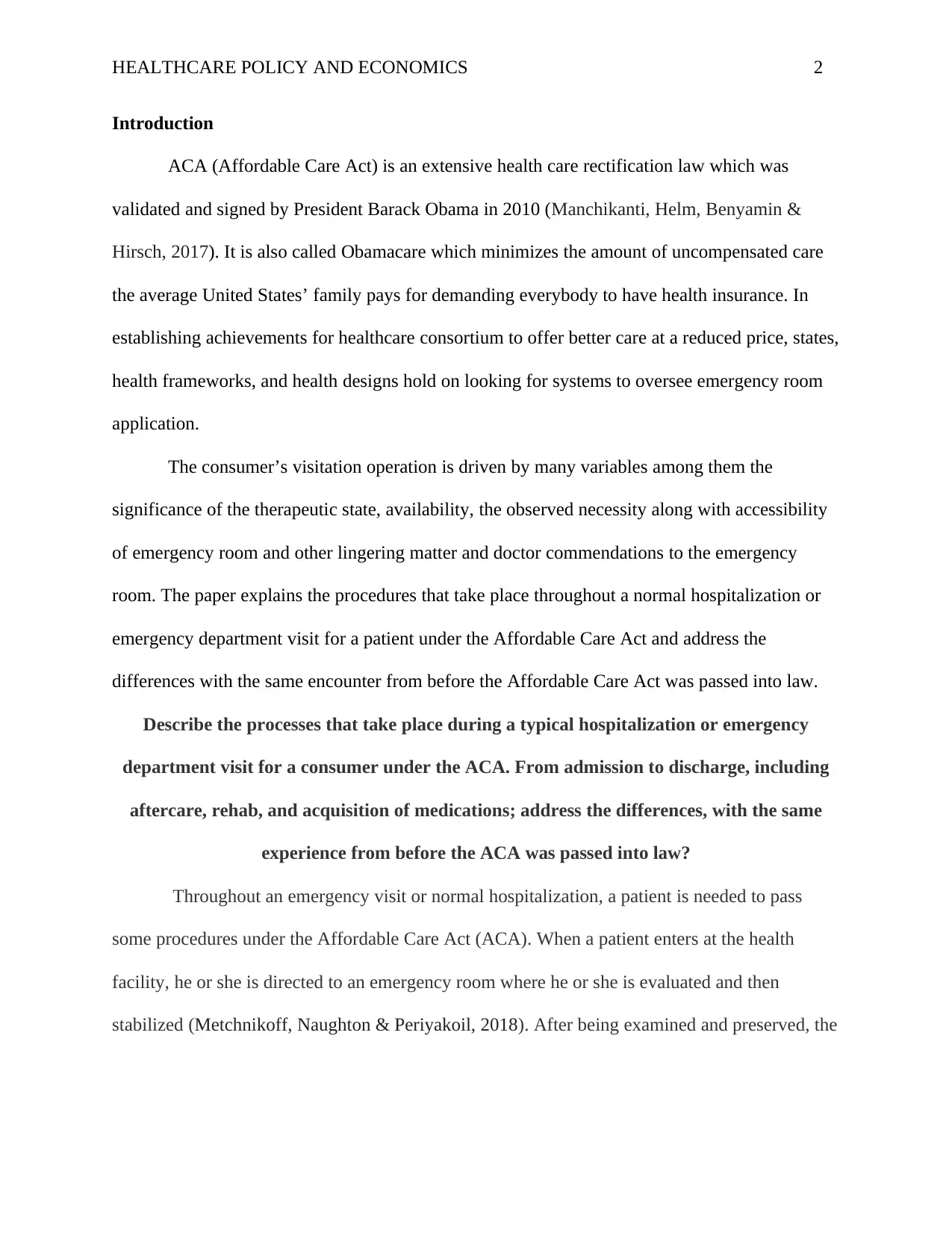
HEALTHCARE POLICY AND ECONOMICS 2
Introduction
ACA (Affordable Care Act) is an extensive health care rectification law which was
validated and signed by President Barack Obama in 2010 (Manchikanti, Helm, Benyamin &
Hirsch, 2017). It is also called Obamacare which minimizes the amount of uncompensated care
the average United States’ family pays for demanding everybody to have health insurance. In
establishing achievements for healthcare consortium to offer better care at a reduced price, states,
health frameworks, and health designs hold on looking for systems to oversee emergency room
application.
The consumer’s visitation operation is driven by many variables among them the
significance of the therapeutic state, availability, the observed necessity along with accessibility
of emergency room and other lingering matter and doctor commendations to the emergency
room. The paper explains the procedures that take place throughout a normal hospitalization or
emergency department visit for a patient under the Affordable Care Act and address the
differences with the same encounter from before the Affordable Care Act was passed into law.
Describe the processes that take place during a typical hospitalization or emergency
department visit for a consumer under the ACA. From admission to discharge, including
aftercare, rehab, and acquisition of medications; address the differences, with the same
experience from before the ACA was passed into law?
Throughout an emergency visit or normal hospitalization, a patient is needed to pass
some procedures under the Affordable Care Act (ACA). When a patient enters at the health
facility, he or she is directed to an emergency room where he or she is evaluated and then
stabilized (Metchnikoff, Naughton & Periyakoil, 2018). After being examined and preserved, the
Introduction
ACA (Affordable Care Act) is an extensive health care rectification law which was
validated and signed by President Barack Obama in 2010 (Manchikanti, Helm, Benyamin &
Hirsch, 2017). It is also called Obamacare which minimizes the amount of uncompensated care
the average United States’ family pays for demanding everybody to have health insurance. In
establishing achievements for healthcare consortium to offer better care at a reduced price, states,
health frameworks, and health designs hold on looking for systems to oversee emergency room
application.
The consumer’s visitation operation is driven by many variables among them the
significance of the therapeutic state, availability, the observed necessity along with accessibility
of emergency room and other lingering matter and doctor commendations to the emergency
room. The paper explains the procedures that take place throughout a normal hospitalization or
emergency department visit for a patient under the Affordable Care Act and address the
differences with the same encounter from before the Affordable Care Act was passed into law.
Describe the processes that take place during a typical hospitalization or emergency
department visit for a consumer under the ACA. From admission to discharge, including
aftercare, rehab, and acquisition of medications; address the differences, with the same
experience from before the ACA was passed into law?
Throughout an emergency visit or normal hospitalization, a patient is needed to pass
some procedures under the Affordable Care Act (ACA). When a patient enters at the health
facility, he or she is directed to an emergency room where he or she is evaluated and then
stabilized (Metchnikoff, Naughton & Periyakoil, 2018). After being examined and preserved, the
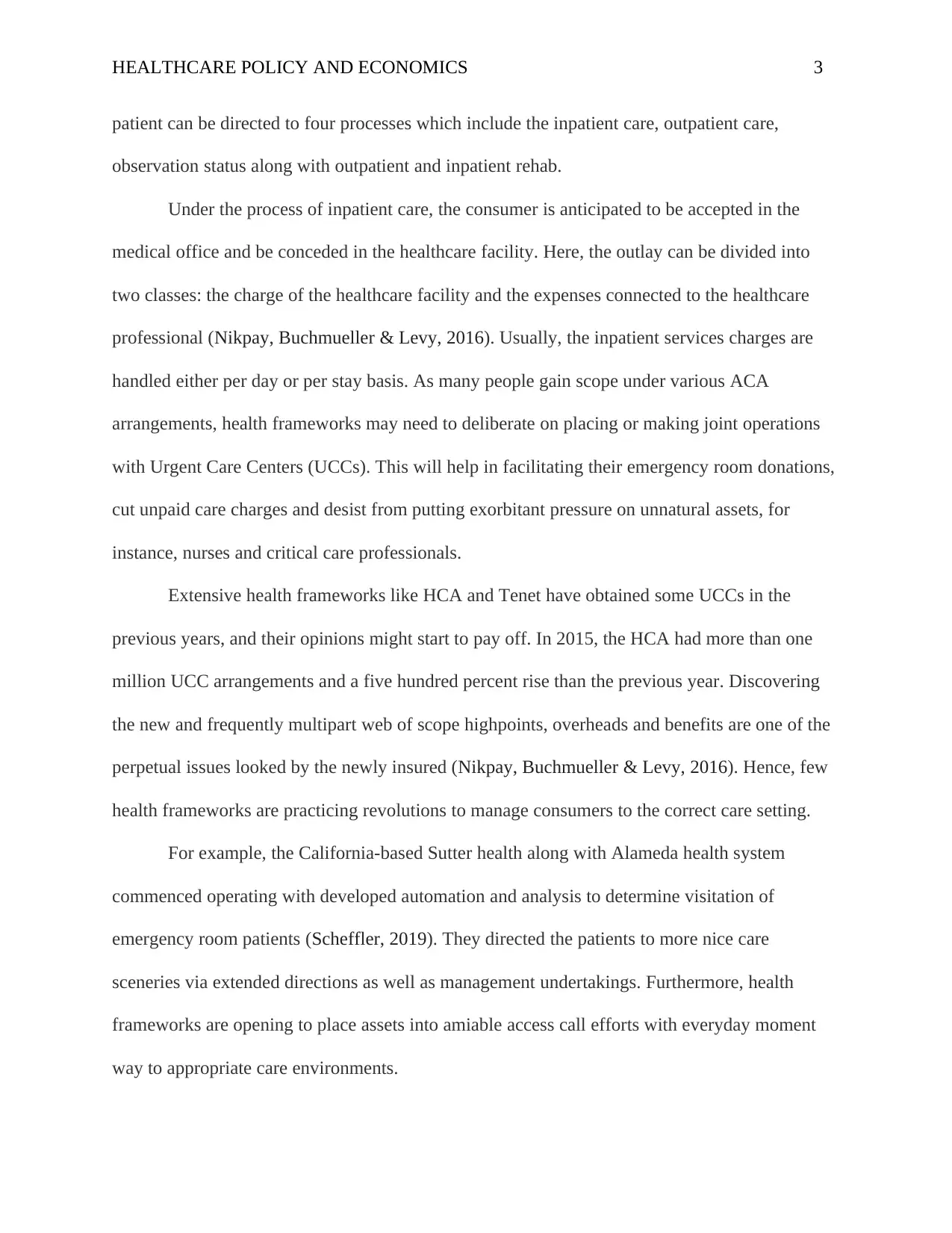
HEALTHCARE POLICY AND ECONOMICS 3
patient can be directed to four processes which include the inpatient care, outpatient care,
observation status along with outpatient and inpatient rehab.
Under the process of inpatient care, the consumer is anticipated to be accepted in the
medical office and be conceded in the healthcare facility. Here, the outlay can be divided into
two classes: the charge of the healthcare facility and the expenses connected to the healthcare
professional (Nikpay, Buchmueller & Levy, 2016). Usually, the inpatient services charges are
handled either per day or per stay basis. As many people gain scope under various ACA
arrangements, health frameworks may need to deliberate on placing or making joint operations
with Urgent Care Centers (UCCs). This will help in facilitating their emergency room donations,
cut unpaid care charges and desist from putting exorbitant pressure on unnatural assets, for
instance, nurses and critical care professionals.
Extensive health frameworks like HCA and Tenet have obtained some UCCs in the
previous years, and their opinions might start to pay off. In 2015, the HCA had more than one
million UCC arrangements and a five hundred percent rise than the previous year. Discovering
the new and frequently multipart web of scope highpoints, overheads and benefits are one of the
perpetual issues looked by the newly insured (Nikpay, Buchmueller & Levy, 2016). Hence, few
health frameworks are practicing revolutions to manage consumers to the correct care setting.
For example, the California-based Sutter health along with Alameda health system
commenced operating with developed automation and analysis to determine visitation of
emergency room patients (Scheffler, 2019). They directed the patients to more nice care
sceneries via extended directions as well as management undertakings. Furthermore, health
frameworks are opening to place assets into amiable access call efforts with everyday moment
way to appropriate care environments.
patient can be directed to four processes which include the inpatient care, outpatient care,
observation status along with outpatient and inpatient rehab.
Under the process of inpatient care, the consumer is anticipated to be accepted in the
medical office and be conceded in the healthcare facility. Here, the outlay can be divided into
two classes: the charge of the healthcare facility and the expenses connected to the healthcare
professional (Nikpay, Buchmueller & Levy, 2016). Usually, the inpatient services charges are
handled either per day or per stay basis. As many people gain scope under various ACA
arrangements, health frameworks may need to deliberate on placing or making joint operations
with Urgent Care Centers (UCCs). This will help in facilitating their emergency room donations,
cut unpaid care charges and desist from putting exorbitant pressure on unnatural assets, for
instance, nurses and critical care professionals.
Extensive health frameworks like HCA and Tenet have obtained some UCCs in the
previous years, and their opinions might start to pay off. In 2015, the HCA had more than one
million UCC arrangements and a five hundred percent rise than the previous year. Discovering
the new and frequently multipart web of scope highpoints, overheads and benefits are one of the
perpetual issues looked by the newly insured (Nikpay, Buchmueller & Levy, 2016). Hence, few
health frameworks are practicing revolutions to manage consumers to the correct care setting.
For example, the California-based Sutter health along with Alameda health system
commenced operating with developed automation and analysis to determine visitation of
emergency room patients (Scheffler, 2019). They directed the patients to more nice care
sceneries via extended directions as well as management undertakings. Furthermore, health
frameworks are opening to place assets into amiable access call efforts with everyday moment
way to appropriate care environments.
⊘ This is a preview!⊘
Do you want full access?
Subscribe today to unlock all pages.

Trusted by 1+ million students worldwide
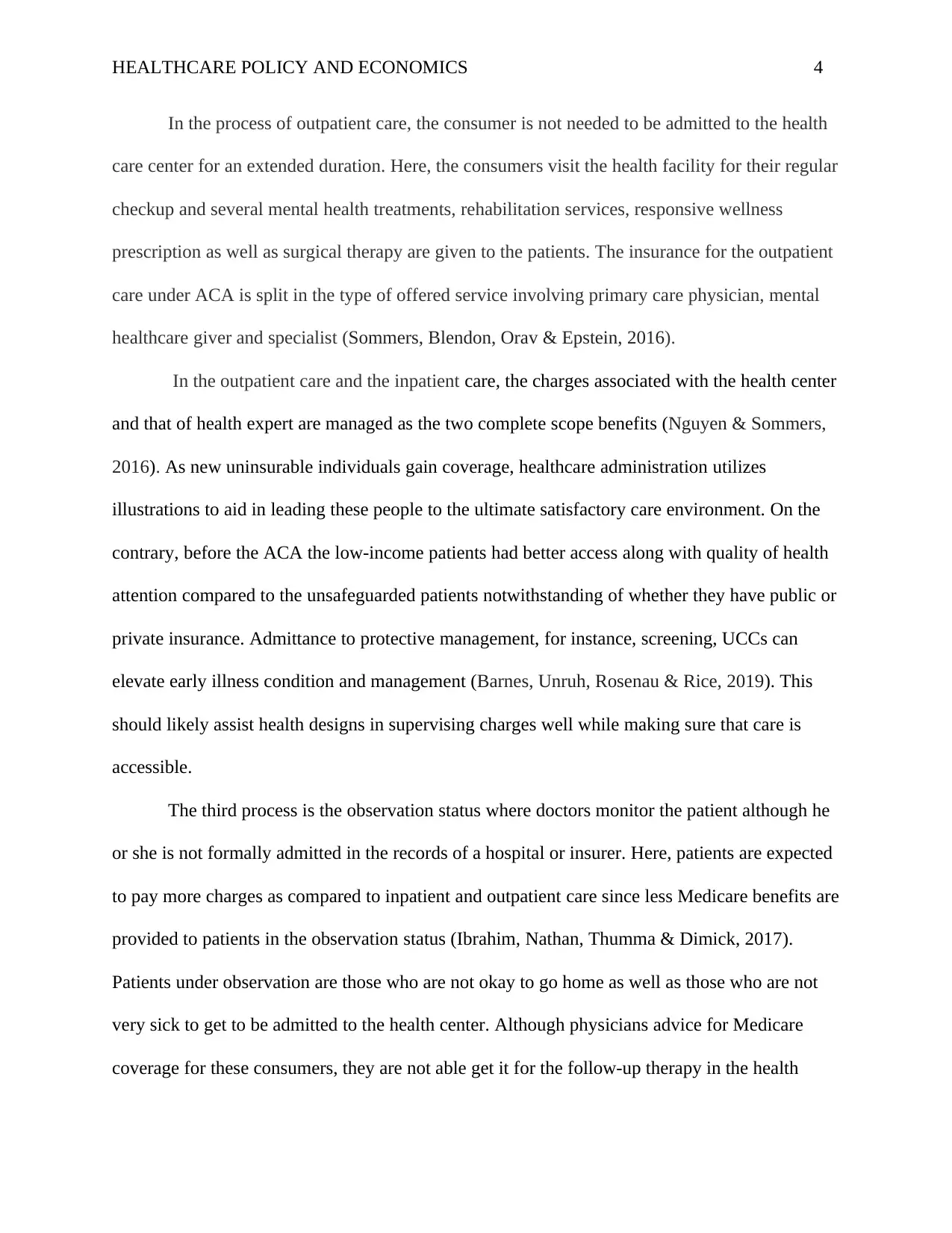
HEALTHCARE POLICY AND ECONOMICS 4
In the process of outpatient care, the consumer is not needed to be admitted to the health
care center for an extended duration. Here, the consumers visit the health facility for their regular
checkup and several mental health treatments, rehabilitation services, responsive wellness
prescription as well as surgical therapy are given to the patients. The insurance for the outpatient
care under ACA is split in the type of offered service involving primary care physician, mental
healthcare giver and specialist (Sommers, Blendon, Orav & Epstein, 2016).
In the outpatient care and the inpatient care, the charges associated with the health center
and that of health expert are managed as the two complete scope benefits (Nguyen & Sommers,
2016). As new uninsurable individuals gain coverage, healthcare administration utilizes
illustrations to aid in leading these people to the ultimate satisfactory care environment. On the
contrary, before the ACA the low-income patients had better access along with quality of health
attention compared to the unsafeguarded patients notwithstanding of whether they have public or
private insurance. Admittance to protective management, for instance, screening, UCCs can
elevate early illness condition and management (Barnes, Unruh, Rosenau & Rice, 2019). This
should likely assist health designs in supervising charges well while making sure that care is
accessible.
The third process is the observation status where doctors monitor the patient although he
or she is not formally admitted in the records of a hospital or insurer. Here, patients are expected
to pay more charges as compared to inpatient and outpatient care since less Medicare benefits are
provided to patients in the observation status (Ibrahim, Nathan, Thumma & Dimick, 2017).
Patients under observation are those who are not okay to go home as well as those who are not
very sick to get to be admitted to the health center. Although physicians advice for Medicare
coverage for these consumers, they are not able get it for the follow-up therapy in the health
In the process of outpatient care, the consumer is not needed to be admitted to the health
care center for an extended duration. Here, the consumers visit the health facility for their regular
checkup and several mental health treatments, rehabilitation services, responsive wellness
prescription as well as surgical therapy are given to the patients. The insurance for the outpatient
care under ACA is split in the type of offered service involving primary care physician, mental
healthcare giver and specialist (Sommers, Blendon, Orav & Epstein, 2016).
In the outpatient care and the inpatient care, the charges associated with the health center
and that of health expert are managed as the two complete scope benefits (Nguyen & Sommers,
2016). As new uninsurable individuals gain coverage, healthcare administration utilizes
illustrations to aid in leading these people to the ultimate satisfactory care environment. On the
contrary, before the ACA the low-income patients had better access along with quality of health
attention compared to the unsafeguarded patients notwithstanding of whether they have public or
private insurance. Admittance to protective management, for instance, screening, UCCs can
elevate early illness condition and management (Barnes, Unruh, Rosenau & Rice, 2019). This
should likely assist health designs in supervising charges well while making sure that care is
accessible.
The third process is the observation status where doctors monitor the patient although he
or she is not formally admitted in the records of a hospital or insurer. Here, patients are expected
to pay more charges as compared to inpatient and outpatient care since less Medicare benefits are
provided to patients in the observation status (Ibrahim, Nathan, Thumma & Dimick, 2017).
Patients under observation are those who are not okay to go home as well as those who are not
very sick to get to be admitted to the health center. Although physicians advice for Medicare
coverage for these consumers, they are not able get it for the follow-up therapy in the health
Paraphrase This Document
Need a fresh take? Get an instant paraphrase of this document with our AI Paraphraser
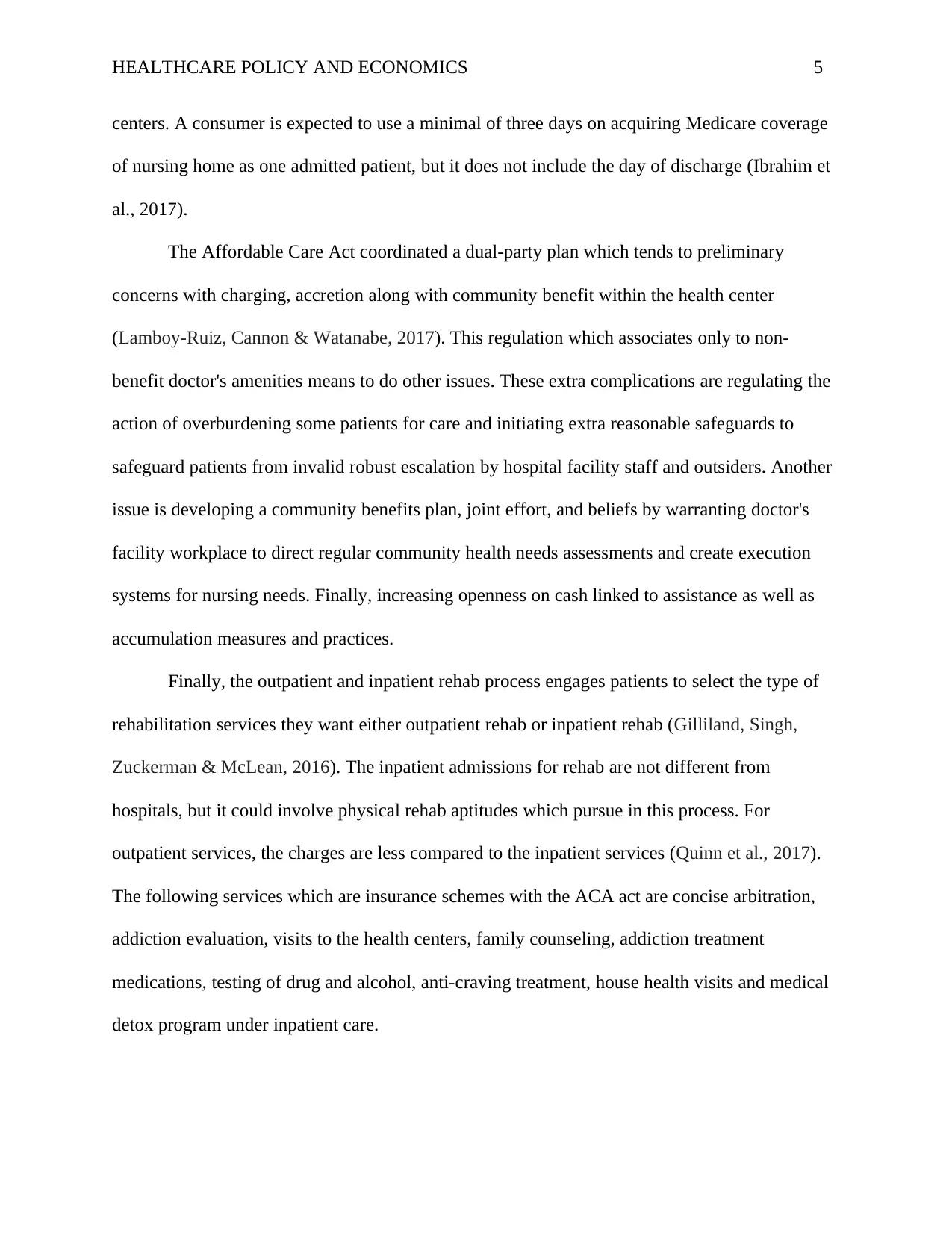
HEALTHCARE POLICY AND ECONOMICS 5
centers. A consumer is expected to use a minimal of three days on acquiring Medicare coverage
of nursing home as one admitted patient, but it does not include the day of discharge (Ibrahim et
al., 2017).
The Affordable Care Act coordinated a dual-party plan which tends to preliminary
concerns with charging, accretion along with community benefit within the health center
(Lamboy-Ruiz, Cannon & Watanabe, 2017). This regulation which associates only to non-
benefit doctor's amenities means to do other issues. These extra complications are regulating the
action of overburdening some patients for care and initiating extra reasonable safeguards to
safeguard patients from invalid robust escalation by hospital facility staff and outsiders. Another
issue is developing a community benefits plan, joint effort, and beliefs by warranting doctor's
facility workplace to direct regular community health needs assessments and create execution
systems for nursing needs. Finally, increasing openness on cash linked to assistance as well as
accumulation measures and practices.
Finally, the outpatient and inpatient rehab process engages patients to select the type of
rehabilitation services they want either outpatient rehab or inpatient rehab (Gilliland, Singh,
Zuckerman & McLean, 2016). The inpatient admissions for rehab are not different from
hospitals, but it could involve physical rehab aptitudes which pursue in this process. For
outpatient services, the charges are less compared to the inpatient services (Quinn et al., 2017).
The following services which are insurance schemes with the ACA act are concise arbitration,
addiction evaluation, visits to the health centers, family counseling, addiction treatment
medications, testing of drug and alcohol, anti-craving treatment, house health visits and medical
detox program under inpatient care.
centers. A consumer is expected to use a minimal of three days on acquiring Medicare coverage
of nursing home as one admitted patient, but it does not include the day of discharge (Ibrahim et
al., 2017).
The Affordable Care Act coordinated a dual-party plan which tends to preliminary
concerns with charging, accretion along with community benefit within the health center
(Lamboy-Ruiz, Cannon & Watanabe, 2017). This regulation which associates only to non-
benefit doctor's amenities means to do other issues. These extra complications are regulating the
action of overburdening some patients for care and initiating extra reasonable safeguards to
safeguard patients from invalid robust escalation by hospital facility staff and outsiders. Another
issue is developing a community benefits plan, joint effort, and beliefs by warranting doctor's
facility workplace to direct regular community health needs assessments and create execution
systems for nursing needs. Finally, increasing openness on cash linked to assistance as well as
accumulation measures and practices.
Finally, the outpatient and inpatient rehab process engages patients to select the type of
rehabilitation services they want either outpatient rehab or inpatient rehab (Gilliland, Singh,
Zuckerman & McLean, 2016). The inpatient admissions for rehab are not different from
hospitals, but it could involve physical rehab aptitudes which pursue in this process. For
outpatient services, the charges are less compared to the inpatient services (Quinn et al., 2017).
The following services which are insurance schemes with the ACA act are concise arbitration,
addiction evaluation, visits to the health centers, family counseling, addiction treatment
medications, testing of drug and alcohol, anti-craving treatment, house health visits and medical
detox program under inpatient care.

HEALTHCARE POLICY AND ECONOMICS 6
Generally, health facilities are not aware if patients are fit for money affiliated aid at the
time of administration or before the expenses are sent. Nonetheless, the laws and Affordable
Care Act do not permit health centers to overcharge consumers who meet all prerequisites for
financial help (Orient, 2017). This is not safe because the law description instructs non-profit
organizations to restrict expenses to consumers who meet all obligations for money affiliated
help or face admonition for nonconformity.
To make consistent with the regulation practice for health institutions, the last directions
provide a secure harbor to medical facilities (Cannon, Lamboy-Ruiz & Watanabe, 2018). The
guidelines conduct a bill consisting of the chargemaster rates or a total more than AGB towards a
patient who is later seen to be fit for financial help with more conditions (Alves, 2019). One
further requirement is that the outlay was not requested as eligibility for acquiring medical
attention. The other one is that at the point of the cost, either the patient is yet to present a full
application for financial assistance or the health institution has not yet made a necessity
declaration.
Conclusion
The processes that take place during an emergency visit under ACA include inpatient
care, outpatient care, and observation status along with outpatient and inpatient rehab. The ACA
was enacted to minimize the amount of uncompensated care the average United States’ family
pays for demanding everybody to have health insurance. It discovers a way of protecting patients
from being overcharged. The act specifies that non-benefit medical centers should charge
patients who are competent for money affiliated assistance at a lower proportion than net charges
for any attention given at the hospital. Moreover, the laws set up an outermost maximum point
Generally, health facilities are not aware if patients are fit for money affiliated aid at the
time of administration or before the expenses are sent. Nonetheless, the laws and Affordable
Care Act do not permit health centers to overcharge consumers who meet all prerequisites for
financial help (Orient, 2017). This is not safe because the law description instructs non-profit
organizations to restrict expenses to consumers who meet all obligations for money affiliated
help or face admonition for nonconformity.
To make consistent with the regulation practice for health institutions, the last directions
provide a secure harbor to medical facilities (Cannon, Lamboy-Ruiz & Watanabe, 2018). The
guidelines conduct a bill consisting of the chargemaster rates or a total more than AGB towards a
patient who is later seen to be fit for financial help with more conditions (Alves, 2019). One
further requirement is that the outlay was not requested as eligibility for acquiring medical
attention. The other one is that at the point of the cost, either the patient is yet to present a full
application for financial assistance or the health institution has not yet made a necessity
declaration.
Conclusion
The processes that take place during an emergency visit under ACA include inpatient
care, outpatient care, and observation status along with outpatient and inpatient rehab. The ACA
was enacted to minimize the amount of uncompensated care the average United States’ family
pays for demanding everybody to have health insurance. It discovers a way of protecting patients
from being overcharged. The act specifies that non-benefit medical centers should charge
patients who are competent for money affiliated assistance at a lower proportion than net charges
for any attention given at the hospital. Moreover, the laws set up an outermost maximum point
⊘ This is a preview!⊘
Do you want full access?
Subscribe today to unlock all pages.

Trusted by 1+ million students worldwide

HEALTHCARE POLICY AND ECONOMICS 7
for the rates non-profit organizations might charge consumers for medically important and
emergency attention.
for the rates non-profit organizations might charge consumers for medically important and
emergency attention.
Paraphrase This Document
Need a fresh take? Get an instant paraphrase of this document with our AI Paraphraser

HEALTHCARE POLICY AND ECONOMICS 8
References
Alves, R. F. P. (2019). Has end-of-life decisions or advance directives become an economic
strategy to contain health care cost as much as a way to respect patient´ s informed
consent and private autonomy rights?-what can we learn from the American advance
care model? (Doctoral dissertation).
Barnes, A. J., Unruh, L. Y., Rosenau, P., & Rice, T. (2019). Health System in the USA. Health
Services Evaluation, 891-925.
Cannon, J. N., Lamboy-Ruiz, M. A., & Watanabe, O. (2018). The Influence of Ownership Type
and the Affordable Care Act on Earnings Management in US Hospitals.
Gilliland, J., Singh, A. R., Zuckerman, L., & McLean, C. (2016). The Affordable Care Act:
Credit Implications for US Hospitals. Municipal Finance Journal, 36(4).
Ibrahim, A. M., Nathan, H., Thumma, J. R., & Dimick, J. B. (2017). Impact of the Hospital
Readmission Reduction Program on surgical readmissions among Medicare
beneficiaries. Annals of surgery, 266(4), 617-624.
Lamboy-Ruiz, M. A., Cannon, J. N., & Watanabe, O. V. (2017). Does State Community Benefits
Regulation Influence Charity Care and Operational Efficiency in US Non-profit
Hospitals? Journal of Business Ethics, 1-25.
Manchikanti, L., Helm, S. I., Benyamin, R. M., & Hirsch, J. A. (2017). Evolution of US Health
Care Reform. Pain Physician, 20(3), 107-110.
Metchnikoff, C., Naughton, G., & Periyakoil, V. S. (2018). End-of-life care for unauthorized
immigrants in the US. Journal of pain and symptom management, 55(5), 1400-1407.
References
Alves, R. F. P. (2019). Has end-of-life decisions or advance directives become an economic
strategy to contain health care cost as much as a way to respect patient´ s informed
consent and private autonomy rights?-what can we learn from the American advance
care model? (Doctoral dissertation).
Barnes, A. J., Unruh, L. Y., Rosenau, P., & Rice, T. (2019). Health System in the USA. Health
Services Evaluation, 891-925.
Cannon, J. N., Lamboy-Ruiz, M. A., & Watanabe, O. (2018). The Influence of Ownership Type
and the Affordable Care Act on Earnings Management in US Hospitals.
Gilliland, J., Singh, A. R., Zuckerman, L., & McLean, C. (2016). The Affordable Care Act:
Credit Implications for US Hospitals. Municipal Finance Journal, 36(4).
Ibrahim, A. M., Nathan, H., Thumma, J. R., & Dimick, J. B. (2017). Impact of the Hospital
Readmission Reduction Program on surgical readmissions among Medicare
beneficiaries. Annals of surgery, 266(4), 617-624.
Lamboy-Ruiz, M. A., Cannon, J. N., & Watanabe, O. V. (2017). Does State Community Benefits
Regulation Influence Charity Care and Operational Efficiency in US Non-profit
Hospitals? Journal of Business Ethics, 1-25.
Manchikanti, L., Helm, S. I., Benyamin, R. M., & Hirsch, J. A. (2017). Evolution of US Health
Care Reform. Pain Physician, 20(3), 107-110.
Metchnikoff, C., Naughton, G., & Periyakoil, V. S. (2018). End-of-life care for unauthorized
immigrants in the US. Journal of pain and symptom management, 55(5), 1400-1407.

HEALTHCARE POLICY AND ECONOMICS 9
Nguyen, K. H., & Sommers, B. D. (2016). Access and quality of care by insurance type for low-
income adults before the Affordable Care Act. American journal of public health, 106(8),
1409-1415.
Nikpay, S., Buchmueller, T., & Levy, H. G. (2016). Affordable Care Act Medicaid expansion
reduced uninsured hospital stays in 2014. Health Affairs, 35(1), 106-110.
Orient, J. M. (2017). White paper on repeal/replacement of the Affordable Care Act. Journal of
American Physicians and Surgeons, 22(1), 25-30.
Quinn, A. E., Hodgkin, D., Perloff, J. N., Stewart, M. T., Brolin, M., Lane, N., & Horgan, C. M.
(2017). Design and impact of bundled payment for detox and follow-up care. Journal of
substance abuse treatment, 82, 113-121.
Scheffler, R. (2019). California Dreamin’: Integrating Health Care, Containing Costs, and
Financing Universal Coverage (Doctoral dissertation, School of Public Health and the
Haas School of Business, University of California, Berkeley).
Sommers, B. D., Blendon, R. J., Orav, E. J., & Epstein, A. M. (2016). Changes in utilization and
health among low-income adults after Medicaid expansion or expanded private
insurance. JAMA internal medicine, 176(10), 1501-1509.
Nguyen, K. H., & Sommers, B. D. (2016). Access and quality of care by insurance type for low-
income adults before the Affordable Care Act. American journal of public health, 106(8),
1409-1415.
Nikpay, S., Buchmueller, T., & Levy, H. G. (2016). Affordable Care Act Medicaid expansion
reduced uninsured hospital stays in 2014. Health Affairs, 35(1), 106-110.
Orient, J. M. (2017). White paper on repeal/replacement of the Affordable Care Act. Journal of
American Physicians and Surgeons, 22(1), 25-30.
Quinn, A. E., Hodgkin, D., Perloff, J. N., Stewart, M. T., Brolin, M., Lane, N., & Horgan, C. M.
(2017). Design and impact of bundled payment for detox and follow-up care. Journal of
substance abuse treatment, 82, 113-121.
Scheffler, R. (2019). California Dreamin’: Integrating Health Care, Containing Costs, and
Financing Universal Coverage (Doctoral dissertation, School of Public Health and the
Haas School of Business, University of California, Berkeley).
Sommers, B. D., Blendon, R. J., Orav, E. J., & Epstein, A. M. (2016). Changes in utilization and
health among low-income adults after Medicaid expansion or expanded private
insurance. JAMA internal medicine, 176(10), 1501-1509.
⊘ This is a preview!⊘
Do you want full access?
Subscribe today to unlock all pages.

Trusted by 1+ million students worldwide
1 out of 9
Related Documents
Your All-in-One AI-Powered Toolkit for Academic Success.
+13062052269
info@desklib.com
Available 24*7 on WhatsApp / Email
![[object Object]](/_next/static/media/star-bottom.7253800d.svg)
Unlock your academic potential
Copyright © 2020–2025 A2Z Services. All Rights Reserved. Developed and managed by ZUCOL.





